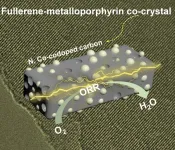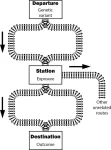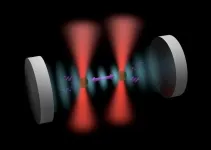(Press-News.org) To find out how planetary systems such as our Solar System form, an international research team including scientists from the University of Cologne studied a stellar nursery, the Orion Nebula, using the James Webb Space Telescope (JWST). By observing a protoplanetary disc named d203-506, they discovered the key role massive stars play in the formation of planetary systems that are less than a million years old. The study, led by Dr Olivier Berné from the National Centre for Scientific Research (CNRS) in Toulouse, was published under the title ‘A far-ultraviolet-driven photoevaporation flow observed in a protoplanetary disk’ in Science.
These stars, which are around ten times more massive, and, more importantly, 100,000 times more luminous than the Sun, expose any planets forming in such systems nearby to very intense ultraviolet radiation. Depending on the mass of the star at the centre of the planetary system, this radiation can either help planets to form, or alternatively prevent them from doing so by dispersing their matter. In the Orion Nebula, the scientists found that, due to the intense irradiation from massive stars, a Jupiter-like planet would not be able to form in the planetary system d203-506.
The team encompasses a wide range of experts from areas such as instrumentation, data reduction and modelling. The data from the JWST were combined with data collected with the Atacama Large Millimeter Array (ALMA) in order to constrain the physical conditions in the gas. The calculated rate at which the disk lost mass implies that the whole disk will evaporate faster than it would take for a giant planet to form.
“It is great that so many contributions from the team over the years, including the planning of the observations and the evaluation the data, are bearing fruit in the form of these results that represent a significant step forward in understanding the formation of planetary systems”, said Dr Yoko Okada from the University of Cologne’s Institute of Astrophysics.
The JWST data in the Orion Nebula is very rich, keeping scientists busy to conduct various detailed analyses in the fields of star- and planet-formation as well as the evolution of the interstellar medium.
END
Ultraviolet radiation from massive stars shapes planetary systems
2024-03-01
ELSE PRESS RELEASES FROM THIS DATE:
Can a purposeful walk intervention with a distance goal using an activity monitor improve individuals' daily activity and function post total hip replacement surgery? A randomized pilot trial
2024-03-01
A research paper by scientists at Bournemouth University proposed a randomized pilot trial, which aimed to determine the effect of an intervention where outdoor walking distance is used as a goal to increase daily activity of older adults using a commercial activity monitor at 3 to 6 months post total hip replacement (THR).
The new research paper, published on Nov. 30 in the journal Cyborg and Bionic Systems, indicated the participants in the intervention group had higher activity levels after THR, compared to those in the control group. The Cohen’s effect ...
Supramolecule combination of fullerene and metalloporphyrin improves zinc-air battery function
2024-03-01
Zinc-air batteries are an inexpensive, powerful battery alternative that can be used on the small scale to power electronics or on the large scale for electric vehicles or energy storage. These batteries work when oxygen from the air oxidizes zinc, but the difficulty in oxygen activation which degrades battery performance has prevented their wide commercial adoption.
Information presented in a paper published in Carbon Future on 19 January shows how fullerene- metalloporphyrin derived carbon materials as catalysts can improve the performance and stability of zinc-air batteries.
“The sluggish kinetic characteristics caused by the difficulty ...
BPA exposure linked to gut microbiota, childhood obesity in new study
2024-03-01
Highlights:
A chemical called Bisphenol A (BPA) is used to make many durable plastics and resins.
Previous studies suggest high BPA exposure can increase health risks and change gut microbiome structure.
Researchers investigated links between BPA exposure, obesity and the gut microbiome.
The study found that normal-weight children had more unique bacteria taxa, which may help degrade BPA.
The findings may help point to microbial strains that neutralize BPA in the gut.
Washington, D.C. — March 1, 2024 — A synthetic chemical called Bisphenol A, or BPA, is widely used in the production of durable plastic products including eyewear, ...
Argonne upgrade lets data portal users “get NERDE” about economic resilience
2024-03-01
Community leaders and administrators now have a more powerful tool for understanding their communities’ economic strengths and vulnerabilities, thanks to the newly enhanced and cleverly monikered National Economic Resilience Data Explorer (NERDE). The online data portal’s enhanced second edition makes it easier for users to create economic development plans, improve resilience and apply for economic assistance and grants.
NERDE first launched as a partnership between the U.S. Department of Energy’s (DOE) Argonne National ...
Latest booster reduces adults’ risk of moderate or severe COVID by more than half
2024-03-01
The most recent COVID-19 booster shot reduces adults’ risk of moderate or severe COVID by more than half, according to a new nationwide data study from September 2023 through January 2024, a period of JN.1 variant dominance.
The new study is one of the first to evaluate protection provided by the updated shot against COVID-19-associated emergency department and urgent care visits (markers for moderate disease) and against hospitalizations (a marker for severe disease), in individuals 18 and older, due to JN.1, the most ...
Making sense of Mendelian randomization
2024-03-01
Mendelian randomization, a powerful tool in medical research, helps us understand whether certain factors truly cause disease. This technique uses genetic variations as "natural experiments" to reveal cause-and-effect relationships. However, choosing the proper genetic variations is crucial for accurate results.
Think of a train network where the genetic variation is the starting point, the exposure is a station, and the disease is the destination. The train must pass through the exposure station en route to the disease. This represents the critical assumption of Mendelian randomization: ...
Precision pulmonary medicine: Penn engineers target lung disease with lipid nanoparticles
2024-03-01
Penn Engineers have developed a new means of targeting the lungs with lipid nanoparticles (LNPs), the miniscule capsules used by the Moderna and Pfizer-BioNTech COVID-19 vaccines to deliver mRNA, opening the door to novel treatments for pulmonary diseases like cystic fibrosis.
In a paper in Nature Communications, Michael J. Mitchell, Associate Professor in the Department of Bioengineering, demonstrates a new method for efficiently determining which LNPs are likely to bind to the lungs, rather than the liver. “The way the liver is designed,” says Mitchell, “LNPs tend to filter into hepatic cells, and struggle ...
Scientists make nanoparticles dance to unravel quantum limits
2024-03-01
The question of where the boundary between classical and quantum physics lies is one of the longest-standing pursuits of modern scientific research and in new research published today, scientists demonstrate a novel platform that could help us find an answer.
The laws of quantum physics govern the behaviour of particles at miniscule scales, leading to phenomena such as quantum entanglement, where the properties of entangled particles become inextricably linked in ways that cannot be explained by classical physics.
Research in quantum physics ...
Study identifies multi-organ response to seven days without food
2024-03-01
New findings reveal that the body undergoes significant, systematic changes across multiple organs during prolonged periods of fasting. The results demonstrate evidence of health benefits beyond weight loss, but also show that any potentially health-altering changes appear to occur only after three days without food.
The study, published today in Nature Metabolism, advances our understanding of what’s happening across the body after prolonged periods without food.
By identifying the potential health benefits from fasting ...
New microbiome insights could help boost immunotherapy for a range of rare cancers
2024-03-01
The microbiome can identify those who benefit from combination immunotherapy across multiple different cancers, including rare gynaecological cancers, biliary tract cancers and melanoma.
Researchers from the Wellcome Sanger Institute, the Olivia Newton-John Cancer Research Institute in Australia, and collaborators, have identified specific strains of bacteria that are linked with a positive response to combination immunotherapy in the largest study of its kind.
The study, published today (1 March) in Nature Medicine, details a signature collection of microorganisms in an individual’s gut bacteria that may help identify those who would benefit from combination immunotherapy and ...






